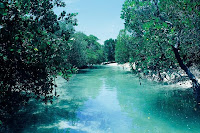Research trip to Belavenoke by BV Volunteer Kristy Benz

We meet Angelo in Andavadoaka village and eat a hearty breakfast of bok-bok (lumps of dough comparable to flavourless doughnuts), bele (a root vegetable which tastes something like sweet potato), and coffee with lots of sugar. Afterwards, we clamber aboard the pirogue that Angelo has magically conjured for us.
The journey to Belavenoke takes about two hours with a favourable wind. Once there, we’re greeted by our hosts and shown to our lodgings. It is very easy to settle in to this simple space with its friendly faces.
After a leisurely lunch we head out for the small mangroves. Caroline already has a few plots set up here. The work is simple enough: tag, measure and classify trees, as well as count all stumps and saplings in the ten by ten metre plot. We get through two plots that first afternoon and set up one more before retiring.

The sunset signals dinner time. We say goodbye to the children and gather around the table under the open-air shelter. It’s a simple meal of fish and rice, but satisfactory following the afternoon’s work. Afterwards we sit and chat with our hosts. The sky is now inky black, and the night cool enough to savour the feeling of trousers and a long-sleeved top. I’m reminded of camping trips from my childhood, except that we’re drinking local rum and speaking a confusing combination of English, French and Malagasy.
We wind down and head to our hard (but extremely comfortable) beds. We rise more or less with the sun, eat breakfast and are back at the mangroves by eight. After finishing the kelikely (small) mangroves, we tackle the bevata (big) ones. More trees, more mud, more confusion and more fun. We’re making terrific headway, though getting from one plot to the other is becoming some kind of extreme sport. We wade across murky streams and clamber over roots and branches. There is an astounding amount of mud and we all wind up covered in it. Each of us gets stuck at least once. By means of the assorted twigs and lichens we also manage to shed enough of our own blood for a proper sacrifice to the mangrove gods. Lunch is forsaken in the name of science and we finish, famished, by four. Somehow we make it back to the epi-bar and are well fed for our efforts.
The next day Ben and Stephanie head homewards on a zebu cart and are replaced by Lucia. We eat lunch, and after a quick briefing set out for the biggest mangroves yet. Today¹s transect lies on an island and we get there by pirogue. Four exhausting hours later we are completely finished and Caroline is ecstatic. As we sail back to Belavenoke, not even the loss of our bailer and a sizeable hole in the bottom of our pirogue can dampen our spirits.
In the morning we catch the pirogue back but with no wind, we each have to take a turn with the paddles. After two hours we’re barely halfway, and are considering delving into the last of the biscuits, when we hear a motor. Four Blue Ventures comrades pull up next to us in a motorized pirogue. We offer to swap the biscuits for a tow, and they agree. Finally the two boats are tied together and we’re off homeward. Later on, Caroline thanks me for coming along. I look back over the past three days and cannot figure out what she is thanking me for. It should be me thanking her, and I do.

No comments:
Post a Comment